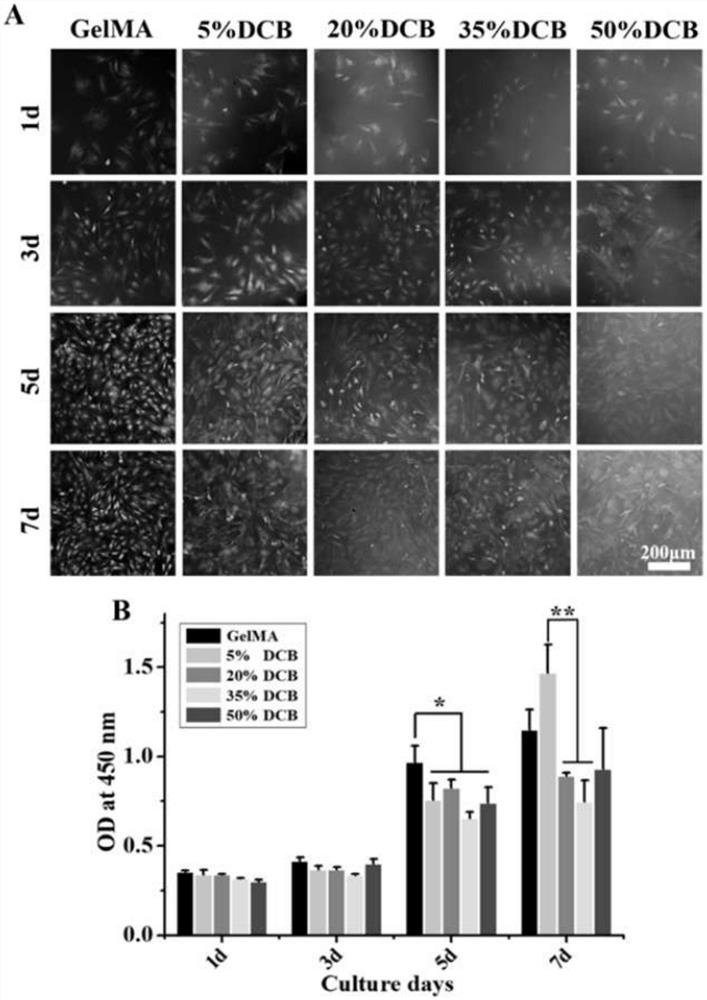Preparation method and application of blended hydrogel biological scaffold material with biological activity
A technology of biological activity and scaffold materials, applied in the field of preparation of blended hydrogel bio-scaffold materials, can solve the problems of lack of biological activity, complex operation, strong immune response, etc., and achieve simple and easy-to-operate experimental methods and biocompatibility Good, easy to process and shape effect
- Summary
- Abstract
- Description
- Claims
- Application Information
AI Technical Summary
Problems solved by technology
Method used
Image
Examples
Embodiment 1
[0034] Such as Figure 1 to Figure 5 As shown, the invention discloses a preparation method of a bioactive blended hydrogel bioscaffold material,
[0035] (1) Weigh 20% w / v GelMA solid, add it to a 5ml centrifuge tube containing 2ml deionized water, dissolve in a 37°C water bath, shake and mix;
[0036] (2) Weigh 5% decellularized bone powder, add it to the dissolved solution in step (1), dissolve in a 37°C water bath, shake and mix;
[0037] (3) Weigh 0.1% w / v photoinitiated crosslinking agent Ig2959, add it to the mixed solution in step (2), shake and mix well; the photoinitiated crosslinking agent is 2-hydroxy-2-methyl-1- [4-(2-Hydroxyethoxy)phenyl]-1-propanone.
[0038] (4) Clean the polytetrafluoroethylene mold with a diameter of 8 mm and a depth of 1 mm, and dry it for use.
[0039] (5) Drop 60 μl of the mixed solution prepared in step (3) into the polytetrafluoroethylene mold prepared in step (4);
[0040] (6) Place the material prepared in step (5) under a 365nm ul...
Embodiment 2
[0043] (1) Weigh 20% w / v GelMA solid, add it to a 5ml centrifuge tube containing 2ml deionized water, dissolve in a 37°C water bath, shake and mix;
[0044] (2) Weigh 20% of the decellularized bone powder, add it to the dissolved solution in step (1), dissolve in a 37°C water bath, shake and mix;
[0045](3) Weigh 0.1% w / v photoinitiated cross-linking agent Ig2959, add it to the mixed solution in step (2), shake and mix;
[0046] (4) Clean the polytetrafluoroethylene mold with a diameter of 8 mm and a depth of 1 mm, and dry it for use.
[0047] (5) Drop 60 μl of the mixed solution prepared in step (3) into the polytetrafluoroethylene mold prepared in step (4);
[0048] (6) Place the material prepared in step (5) under a 365nm ultraviolet lamp and irradiate it for 2 minutes, and the photocrosslinking is completed;
[0049] (7) The material obtained in step (6) is soaked in the buffer solution and stored.
Embodiment 3
[0051] (1) Weigh 20% w / v GelMA solid, add it to a 5ml centrifuge tube containing 2ml deionized water, dissolve in a 37°C water bath, shake and mix;
[0052] (2) Weigh 35% decellularized bone powder, add it to the dissolved solution in step (1), dissolve in a 37°C water bath, shake and mix;
[0053] (3) Weigh 0.1% w / v photoinitiated cross-linking agent Ig2959, add it to the mixed solution in step (2), shake and mix;
[0054] (4) Clean the polytetrafluoroethylene mold with a diameter of 8 mm and a depth of 1 mm, and dry it for use.
[0055] (5) Drop 60 μl of the mixed solution prepared in step (3) into the polytetrafluoroethylene mold prepared in step (4);
[0056] (6) Place the material prepared in step (5) under a 365nm ultraviolet lamp and irradiate it for 2 minutes, and the photocrosslinking is completed;
[0057] (7) The material obtained in step (6) is soaked in the buffer solution and stored.
PUM
| Property | Measurement | Unit |
|---|---|---|
| thickness | aaaaa | aaaaa |
| diameter | aaaaa | aaaaa |
| depth | aaaaa | aaaaa |
Abstract
Description
Claims
Application Information
 Login to View More
Login to View More - R&D
- Intellectual Property
- Life Sciences
- Materials
- Tech Scout
- Unparalleled Data Quality
- Higher Quality Content
- 60% Fewer Hallucinations
Browse by: Latest US Patents, China's latest patents, Technical Efficacy Thesaurus, Application Domain, Technology Topic, Popular Technical Reports.
© 2025 PatSnap. All rights reserved.Legal|Privacy policy|Modern Slavery Act Transparency Statement|Sitemap|About US| Contact US: help@patsnap.com



